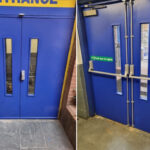Understanding the Difference Between a Fire Door and a Regular Door
Doors are a fundamental part of any building, serving as entryways and exits while providing security and privacy. However, not all doors are created equal. When it comes to safety, particularly in the event of a fire, the distinction between a fire door and a regular door becomes crucial. In this blog post, we’ll explore the significant differences between these two types of doors and the critical role fire doors play in safeguarding lives and property during emergencies.
Purpose and Function:
The primary purpose of a regular door is to provide access and partition spaces within a building. They are designed with various materials and styles to suit different aesthetics and functionality requirements. Regular doors are not intended to prevent the spread of fire and are not subject to the same stringent safety standards as fire doors.
Fire doors, on the other hand, are specifically engineered to inhibit the rapid propagation of fire, smoke, and toxic fumes throughout a building. Their main function is to compartmentalize areas, creating fire-resistant barriers that allow occupants more time to escape and first responders an opportunity to contain the fire.
Fire Resistance Rating:
The critical difference between a fire door and a regular door lies in their fire resistance rating. A fire door is rigorously tested and certified to withstand fire for a specific duration, typically ranging from 20 minutes to 180 minutes (1 hour to 3 hours). The fire resistance rating is determined based on how long the door can maintain its integrity and prevent the spread of flames and smoke.
In contrast, regular doors lack this fire resistance rating and are not designed to withstand the extreme conditions of a fire. They are made from standard materials, such as wood, metal, or glass, which can quickly succumb to high temperatures and contribute to the fire’s rapid progression.
Construction and Materials:
Fire doors are constructed using fire-resistant materials such as vermiculite boards, gypsum, steel, or a combination of these. The door frames and seals are also specially designed to provide a tight fit when closed, preventing the passage of smoke and flames around the edges.
Regular doors may use combustible materials like untreated wood, hollow-core designs, or non-fire-rated glass, making them unsuitable for use in fire-prone areas. When exposed to fire, these doors can become an accelerant, causing flames to spread rapidly.
Self-Closing Mechanism:
One distinctive feature of fire doors is their self-closing mechanism. Fire doors are typically equipped with automatic door closers, which ensure that the door closes and latches securely after it has been opened. This feature is critical in containing the fire and restricting its movement to a specific area.
Regular doors often lack this self-closing mechanism, relying on manual closing by individuals, which can be easily overlooked during the chaos of an emergency.
Labeling and Certification:
Fire doors are subjected to stringent testing procedures in accredited laboratories to verify their fire resistance rating and performance. Once they pass these tests, they receive certification labels that indicate their fire rating and other relevant information. These labels are typically found on the top edge or frame of the door.
Regular doors are not subjected to the same level of testing and certification because they are not intended for fire protection purposes.
Conclusion:
In conclusion, the differences between a fire door and a regular door are substantial and have a profound impact on the safety of building occupants during a fire emergency. Regular doors are meant for general access and separation, but they lack the critical features and fire resistance rating needed to contain the spread of fire. Fire doors, on the other hand, are purpose-built to save lives and protect property by delaying the spread of fire, providing essential time for evacuation and firefighting efforts.
When designing or evaluating the safety measures of a building, it is essential to understand the role of fire doors and ensure that they are appropriately installed, well-maintained, and comply with relevant safety standards. The proper use of fire doors can make a significant difference in minimizing the devastating effects of a fire and securing the well-being of all building occupants.


